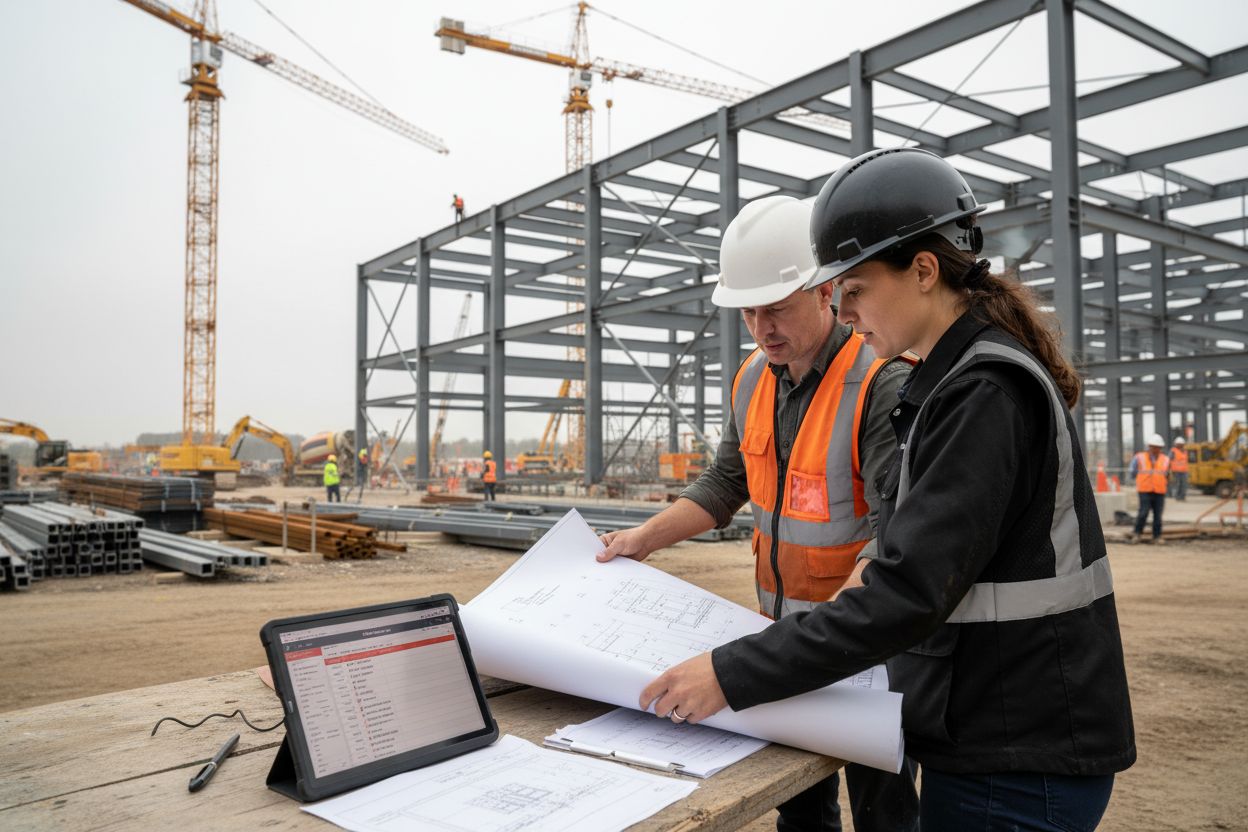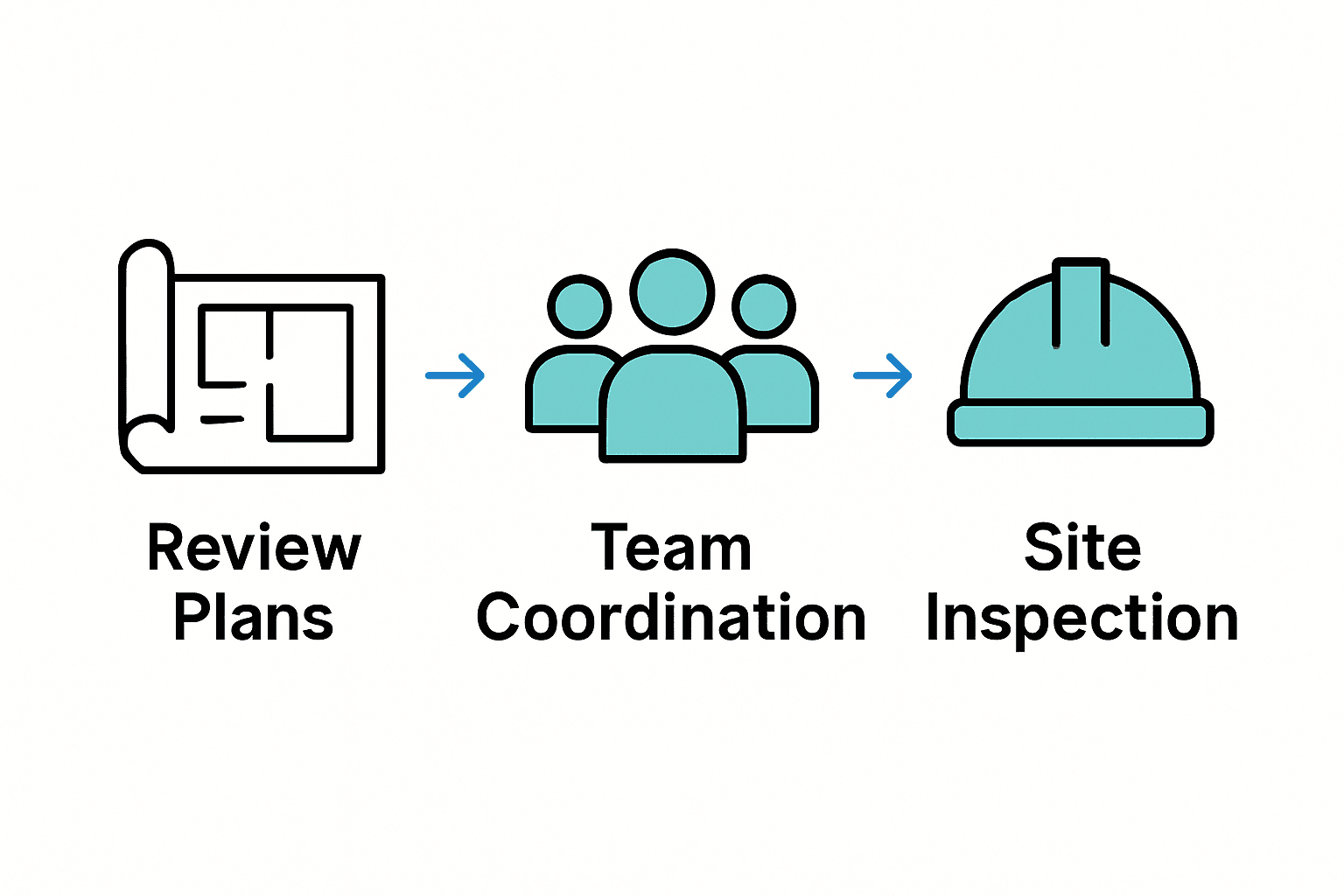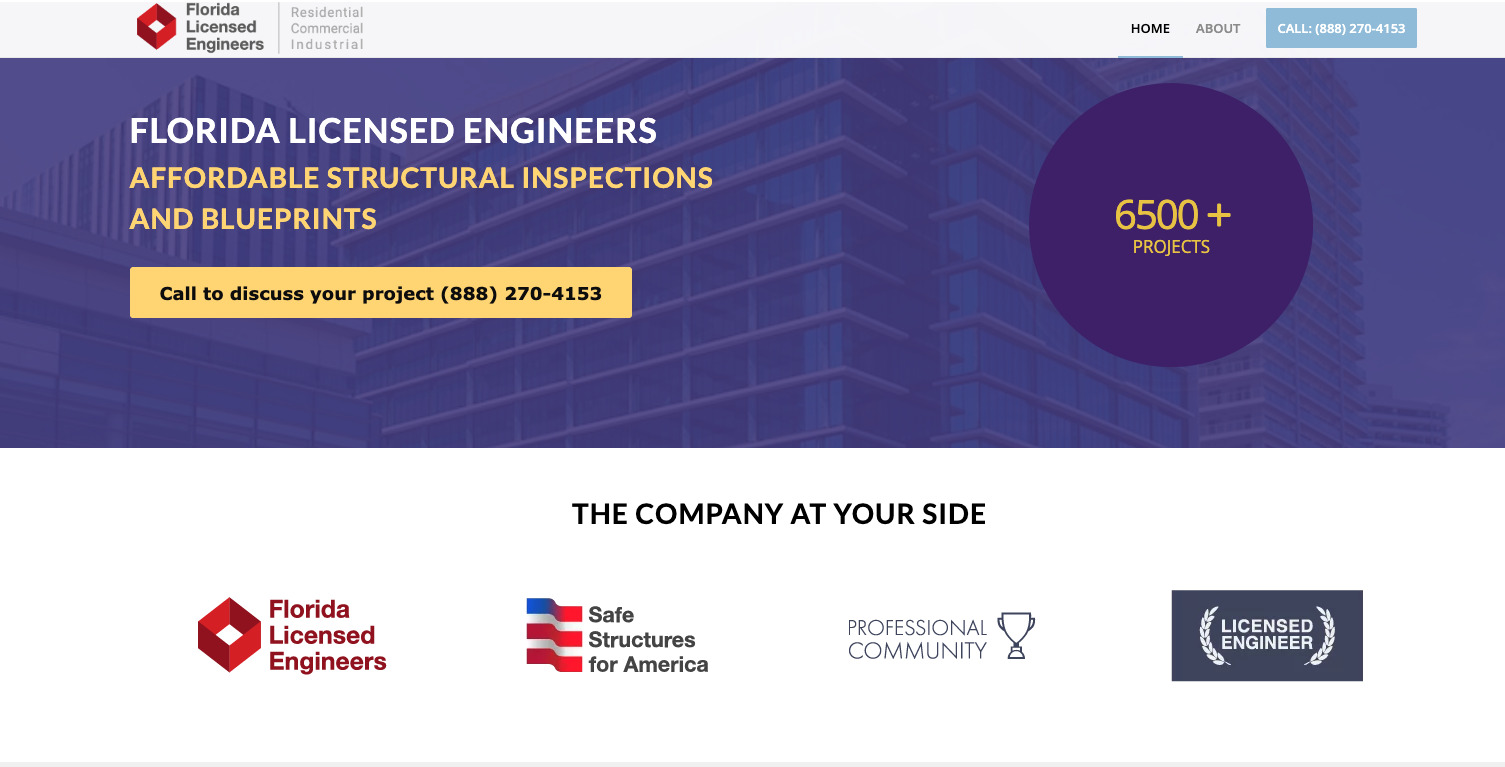How to Prepare for Engineering Inspection with Confidence
Nearly 65 percent of project delays in engineering stem from overlooked documentation or miscommunication between teams. For anyone navigating a major construction project, staying ahead of these setbacks can mean the difference between smooth progress and unnecessary headaches. By focusing on proven steps for thorough preparation, you can identify risks early, keep everyone in sync, and set your project up for a successful inspection outcome.
Quick Summary
| Key Point | Explanation |
|---|---|
| 1. Review all project documents thoroughly | Start with a detailed review of blueprints, inspection reports, and compliance documentation to identify discrepancies and prepare for inspection. |
| 2. Foster strong team communication | Schedule regular meetings and utilize centralized platforms to ensure all engineering and contractor teams are aligned on inspection readiness. |
| 3. Inspect site conditions against plans | Conduct a thorough site inspection comparing actual conditions with documented plans to identify potential compliance issues early. |
| 4. Create a detailed deficiency log | Document any deficiencies found during the site inspection with prioritization to address compliance issues systematically. |
| 5. Follow up on inspection findings diligently | After the inspection, review the report, create an action plan, and engage the inspection team for clarification on any concerns. |
Table of Contents
- Step 1: Review Project Plans And Documentation
- Step 2: Coordinate With Your Engineering And Contractor Teams
- Step 3: Inspect Site For Compliance And Readiness
- Step 4: Address Deficiencies And Make Necessary Corrections
- Step 5: Confirm Documentation And Schedule The Inspection
- Step 6: Verify Inspection Completion And Follow Up
Step 1: Review project plans and documentation
Reviewing project plans and documentation is your critical first step in preparing for a successful engineering inspection. This phase sets the foundation for understanding the entire project scope, potential challenges, and ensuring compliance with all required standards.
Start by gathering all architectural blueprints, previous inspection reports, and relevant project documentation. According to operational readiness research, having all documents readily available and up to date is crucial for smooth inspection preparation. Spread these materials out on a clean workspace where you can examine them thoroughly.
Begin your review by checking the project plan’s comprehensive details. Look for approved documentation that has been shared with all stakeholders. Pay special attention to structural blueprints, as they reveal critical information about design specifications, material requirements, and potential areas of concern.
Create a systematic checklist during your document review. Break down your examination into key categories like architectural design, structural integrity, safety protocols, and environmental compliance. This approach helps ensure you do not miss any critical elements during your initial document assessment.
Here’s a summary of key document categories to review:
| Category | Purpose | Key Documents |
|---|---|---|
| Architectural Design | Defines project layout & style | Blueprints Design approvals |
| Structural Integrity | Ensures load-bearing compliance | Structural drawings Calculations |
| Safety Protocols | Meets regulatory safety standards | Safety plans Inspection reports |
| Environmental Compliance | Fulfills environmental mandates | Permits Environmental assessments |
Pro Tip: Always maintain digital and physical copies of all documentation, and verify that each document is the most recent version to prevent potential inspection complications.
As you review the plans, note any discrepancies or areas that might require further investigation. Flag documents that seem incomplete or raise questions. This preliminary review will help you prepare targeted questions and focus areas for the upcoming site inspection.
Next, you will be ready to develop a comprehensive site inspection strategy based on these meticulously reviewed project documents.
Step 2: Coordinate with your engineering and contractor teams
Coordinating effectively with your engineering and contractor teams transforms a potentially stressful inspection process into a smooth collaborative effort. Your goal is to create a unified communication strategy that keeps everyone informed, aligned, and prepared.
According to construction inspection best practices, daily communication is the cornerstone of successful project coordination. Schedule regular site meetings where all team members can discuss progress, potential challenges, and inspection readiness. During these meetings, create an open environment where contractors feel comfortable sharing their insights and concerns.
Utilize modern technology to streamline your communication. Research shows that using a centralized data repository like cloud based storage dramatically improves team collaboration. Choose a project management platform where all team members can access current documents, track updates, and communicate in real time.
Pro Tip: Establish a clear communication protocol that defines who communicates what, when, and through which channels to prevent information bottlenecks.
Ensure that every team member understands their specific role in the upcoming inspection. Provide each contractor and engineer with a detailed briefing that outlines expectations, potential focus areas, and their individual responsibilities. This clarity helps prevent last minute confusion and demonstrates professional preparation.
Encourage a feedback loop where team members can quickly report potential issues or suggest improvements. Quick communication and proactive problem solving will significantly enhance your inspection readiness.
With your team aligned and informed, you are now prepared to move forward with comprehensive site preparation and final documentation review.
Step 3: Inspect site for compliance and readiness
Inspecting the site for compliance and readiness is your critical opportunity to validate that everything matches the project plans and meets regulatory standards. This comprehensive walkthrough will help you identify potential issues before the official engineering inspection.
Begin your site inspection by carefully comparing the actual site conditions with the documented project plans. As research indicates, site access and documentation accuracy are fundamental challenges in infrastructure compliance. Walk the entire site methodically, documenting any discrepancies between the planned design and current reality.
Modern structural engineering recommends using mobile tools and real time data collection techniques during your inspection. Learn more about our site assessment process to understand how technology can enhance your inspection accuracy. Leverage digital measurement tools, take detailed photographs, and record precise measurements that can be cross referenced with your project documentation.
Pro Tip: Bring multiple reference documents including blueprints, previous inspection reports, and regulatory compliance checklists to ensure comprehensive site evaluation.
Focus your inspection on key compliance areas such as structural integrity, safety protocols, material quality, and environmental considerations. Check for potential safety hazards, verify material specifications, and ensure all construction elements align with approved plans. Pay special attention to foundational elements, load bearing structures, and areas with complex engineering requirements.
Document everything systematically. Create a detailed report that highlights observations, potential concerns, and areas that might require additional review or correction. Your thorough documentation will demonstrate professional diligence and help streamline the upcoming official engineering inspection.

With your site thoroughly inspected and documented, you are now prepared to address any identified issues before the final engineering review.
Step 4: Address deficiencies and make necessary corrections
Addressing site deficiencies requires a strategic and systematic approach to ensure your project meets all engineering and regulatory standards. This critical step transforms potential roadblocks into opportunities for improvement and demonstrates your team’s commitment to quality.
Start by creating a comprehensive deficiency log from your site inspection findings. Prioritize these issues based on their potential impact on project compliance and safety. Some problems might require immediate correction, while others can be addressed through careful planning and phased improvements.
According to documentation review strategies, our comprehensive site assessment guide recommends conducting a final mock audit to verify all corrections. This process helps you simulate an official inspection and catch any remaining gaps in your preparation.
Pro Tip: Assign specific team members to each identified deficiency, setting clear timelines and accountability for resolution.
Engage your engineering and contractor teams directly in the correction process. Schedule a detailed review meeting where you walk through each identified issue, discussing potential solutions and implementation strategies. Collaborative problem solving ensures that corrections are not just cosmetic but address the root causes of any compliance challenges.
Document every correction meticulously. Take before and after photographs, maintain detailed records of changes made, and ensure that all modifications align with original project specifications. This documentation serves as proof of your proactive approach and commitment to meeting high engineering standards.
With deficiencies systematically addressed and documented, you are now prepared for the final steps of your engineering inspection preparation.
Step 5: Confirm documentation and schedule the inspection
Your final step in preparing for an engineering inspection involves meticulously confirming all documentation and strategically scheduling the official review. This critical phase transforms your preparation into a tangible pathway toward project approval.
Begin by conducting a comprehensive document audit. According to operational readiness research, a structured checklist is essential for ensuring all project plans and certifications are complete and approved. Gather every permit, blueprint, correction record, and compliance document into a single organized portfolio.
Explore our comprehensive inspection preparation services to understand the nuanced requirements of professional documentation management. Review each document carefully to confirm they represent the most current project status and include all necessary stakeholder approvals.
Pro Tip: Create a digital backup of all documentation and maintain both electronic and physical copies to prevent potential loss or confusion.
Contact the relevant engineering inspection authority to schedule your review. Provide them with a complete documentation package and be prepared to discuss any recent modifications or corrections made to the project. Select a date that allows sufficient buffer time in case any last minute adjustments are required.
During scheduling, confirm the specific requirements of the inspection. Some authorities might need additional paperwork or have unique protocols. Ask about their preferred documentation format and any supplemental information they might require.
With your documentation confirmed and inspection scheduled, you have successfully navigated the complex preparation process and positioned your project for a smooth professional review.
Step 6: Verify inspection completion and follow up
The final stage of your engineering inspection journey involves carefully reviewing the official inspection report and taking strategic actions based on its findings. This process transforms the inspection from a one time event into an opportunity for continuous improvement and project excellence.
Immediately after receiving the inspection report, schedule a comprehensive team review meeting. Carefully analyze each observation, recommendation, and potential area of concern identified by the inspectors. Pay close attention to both critical issues and minor suggestions that could enhance your project’s overall quality.
According to documentation review strategies, learn more about our post inspection support services to understand how professional follow up can maximize your project’s success. Create a structured action plan that prioritizes addressing each finding systematically and efficiently.
Pro Tip: Establish a tracking system that documents the status of each inspection recommendation, assigning clear ownership and deadlines for resolution.
Engage directly with the inspection team if any findings require clarification. Approach these conversations professionally and collaboratively, demonstrating your commitment to meeting and exceeding regulatory standards. Request detailed explanations for any complex observations and seek specific guidance on implementing recommended improvements.
Document your corrective actions meticulously. Prepare a comprehensive response that outlines how you will address each finding, including timelines, responsible team members, and specific implementation strategies. This proactive approach shows your dedication to quality and continuous improvement.
By thoroughly following up on the inspection report, you transform a potential challenge into an opportunity for enhancing your project’s overall quality and compliance.

Take the Stress Out of Engineering Inspections—Get Professional Support
Preparing for an engineering inspection is overwhelming. Sorting through endless blueprints, addressing deficiencies, and making sure your project meets every regulation can leave you with more questions than answers. Many project owners struggle with organizing plans, coordinating teams, and confirming every detail is inspection-ready. These challenges often lead to costly delays or failed reviews.

Why tackle this alone? The experts at Florida Licensed Engineers bring unmatched experience in project documentation, permitting expediting, and thorough inspection services for both residential and commercial needs. When you need reliable guidance for civil engineering, forensic reports, or meticulous site plans, our team delivers clarity and peace of mind. Ready to ensure your inspection goes smoothly? Visit our main site now or explore our expertise in structural engineering support to put your project on the right track today.
Frequently Asked Questions
How can I gather necessary documentation for an engineering inspection?
To prepare for an engineering inspection, start by collecting all relevant documents such as architectural blueprints, previous inspection reports, and safety plans. Organize these materials on a clean workspace for thorough examination, ensuring everything is up to date.
What specific areas should I focus on during the site inspection?
During the site inspection, prioritize checking structural integrity, safety protocols, material quality, and environmental compliance. Systematically review these areas to identify any discrepancies with your project plans, aiming to document your findings clearly.
How can I effectively coordinate with my engineering and contractor teams?
Ensure effective coordination by scheduling regular site meetings to discuss inspection readiness and progress. Create an open communication environment where team members can share insights, and make use of a project management platform for real-time document sharing.
What steps should I take if I identify deficiencies during the inspection?
Upon discovering deficiencies, create a detailed deficiency log and prioritize issues based on their impact on compliance and safety. Collaborate with your team to address these concerns, set clear timelines for corrections, and verify changes through a final mock audit.
How do I confirm all documents are ready before the engineering inspection?
Confirm document readiness by conducting a comprehensive audit of all project plans, certifications, and correction records. Use a structured checklist to ensure everything is complete and approved before scheduling your inspection.
What should I do following the engineering inspection results?
After receiving the inspection results, schedule a team review meeting to analyze the findings and create a structured action plan. Document corrective actions and assign responsibilities, ensuring that all concerns are addressed in a timely manner to improve project quality.




